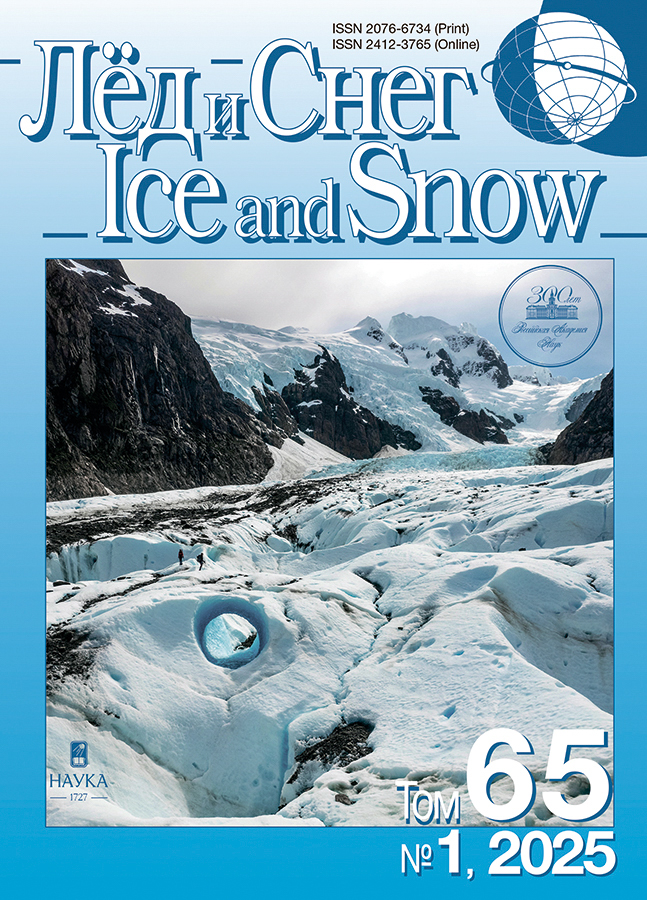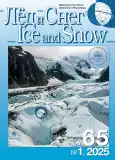Approach to the assessment of ground surface temperature under snow cover based on measurements in Svalbard
- Authors: Sosnovsky A.V.1, Osokin N.I.1
-
Affiliations:
- Institute of Geography, Russian Academy of Sciences
- Issue: Vol 65, No 1 (2025)
- Pages: 93-102
- Section: Snow cover and avalanches
- URL: https://journal-vniispk.ru/2076-6734/article/view/292611
- DOI: https://doi.org/10.31857/S2076673425010079
- EDN: https://elibrary.ru/GYXNOY
- ID: 292611
Cite item
Abstract
Ground temperature in winter is one of important parameters for evaluating the functioning of natural and technical systems. This temperature is formed under the influence of two factors –the air temperature and snow cover properties. At the same time, it is not always possible to measure the temperature of the ground during the cold season. A simple and easily available method has been developed to estimate the surface temperature from thickness of the snow cover and the air temperature. Based on mathematical modeling, numerical experiments were carried out to determine the temperature regime of the ground under the snow cover using different values of snow thickness, the snow density and the air temperature. The mathematical model was tested against data of measurements of the dynamics of ground freezing in the area of the Barentsburg weather station in Western Svalbard. The ratio of snow density and its thickness was analyzed and the most common pairs of values of these parameters for snow thickness/density were obtained: 1/290; 0.75/270; 0.5/250; 0.3/200 m/(kg/m3). The results of numerical experiments made it possible to determine the temperature of the ground under snow and to calculate the relationship between the air and the ground temperatures. It was found that when the air temperature changes within the range from –20 to –40 °C, this ratio practically does not depend on the air temperature, but only on the parameters of the snow cover. With a snow thickness of 1 m, the ratio is 0.435 and 0.286 at air temperatures of –10 °C and –20 ... –40 °C, respectively. As a result, dependencies for calculating the difference between the temperature of the ground under snow and air temperature on the height of the snow cover and atmospheric air temperature have been obtained. Calculations have shown that this difference is 12.8 and 4.5 °C with a snow cover height of 0.5 m and an air temperature of –20 and –10 °C, respectively. Influence of snow density, soil moisture and the summer air temperature upon the ground surface temperature was estimated. The calculations of ground surface temperature were verified using measured data from Western Svalbard.
About the authors
A. V. Sosnovsky
Institute of Geography, Russian Academy of Sciences
Author for correspondence.
Email: alexandr_sosnovskiy@mail.ru
Russian Federation, Moscow
N. I. Osokin
Institute of Geography, Russian Academy of Sciences
Email: alexandr_sosnovskiy@mail.ru
Russian Federation, Moscow
References
- Anisimov O.A., Streletsky D.A. Geocryological risks in the melting of permafrost soils. Arktika XXI vek. Estestvennye nauki. Arctic twenty-first century. Natural Sciences. 2015, 2 (3): 60–74 [In Russian].
- Votyakov I.N. Fiziko-mehanicheskie svoistva merzlih i ottaivayuschih gruntov Yakutii Physico-mechanical properties of frozen and thawing soils of Yakutia. Novosibirsk: Nauka, 1975: 176 p. [In Russian].
- Vtoroy otsenochnyy doklad Rosgidrometa ob izmeneniyakh klimata i ikh posledstviyakh na territorii Rossiyskoy Federatsii. The second assessment report of Roshydromet on climate change and its consequences on the territory of the Russian Federation. General Summary. Moscow: Roshydromet, 2014: 58 p. [In Russian].
- Otchet o klimaticheskikh riskakh na territorii Rossiyskoy Federatsii. Report on climate risks on the territory of the Russian Federation. Saint Petersburg: Climatic Center of Roshydromet, 2017: 106 p. [In Russian].
- Zaykova N.I., Shishkin A.V., Demina I.V. The evaluation of the influence of snow cover on the temperature regime formation of leached chernozem in irrigated areas. Vestnik Altaiskogo gosudarstvennogo agrarnogo universiteta. Bulletin of the Altai State Agrarian University. 2021, 199 (5): 36–41 [In Russian].
- Nikolaev A.N., Skachkov Yu.B. Influence of snow cover and temperature regime of permafrost soils on the radial growth of trees in Central Yakutia. Zhurnal Sibirskogo federal’nogo universiteta. Seriya: Biologiya. Journ. of the Siberian Federal University. Series: Biology. 2012, 5 (1): 43–51 [In Russian].
- Osnovi proektirovaniya stroitelnih konstrukcii. Opredelenie snegovih nagruzok na pokritiya (GOST R ISO 4355–2016). Bases for design of structures. Determination of snow loads on roofs (ISO 4355:2016, IDT). Moscow: Standardinform, 2017: 37 p. [In Russian].
- Osokin N.I., Sosnovsky A.V., Nakalov P.R., Nenashev S.V. Thermal resistance of snow cover and its effect on the ground freezing. Led i Sneg. Ice and Snow. 2013, 53 (1): 93–103 [In Russian]. https://doi.org/10.15356/2076-6734-2013-1-93-103
- Osokin N.I., Sosnovsky A.V. Spatial and temporal variability of depth and density of the snow cover in Russia. Led i Sneg. Ice and Snow. 2014, 54 (4): 72–80 [In Russian]. https://doi.org/10.15356/2076-6734-2014-4-72-80
- Osokin N.I., Sosnovsky A.V. Field investigation of efficient thermal conductivity of snow cover on Spitsbergen. Led i Sneg. Ice and Snow. 2014, 54 (3): 50−58 [In Russian]. https://doi.org/10.15356/2076-6734-2014-3-50-58
- Osokin N.I., Sosnovskiy A.V. Influence of temperature and dynamics of snow cover on the ground freezing. Kriosfera Zemli. Earth Cryosphere. 2015, 19 (1): 99–105. Retrieved from: http://www.izdatgeo.ru/pdf/krio/2015-1/99.pdf [In Russian].
- Osokin N.I., Sosnovskiy A.V. Influence of snow cover thermal resistance on permafrost stability. Kriosfera Zemli. Cryosphere of the Earth. 2016, 20 (3): 105–112. https://doi.org/10.21782/KZ1560-7496-2016-3(105-112) [In Russian].
- Pavlov A.V. Monitoring kriolitozony. Monitoring of cryolithozone. Novosibirsk: Geo, 2008: 229 p. [In Russian].
- Perevertin K.A., Belolyubcev A.I., Dronova E.A., Asaulyak I.F., Kuznetsov I.A., Mazirov M.A., Vasiliev T.A. Impact of changes in snow cover regime on agronomic risks causing pink snow mold. Led i Sneg. Ice and Snow. 2022, 62 (1): 75–80. https://doi.org/10.31857/S2076673422010117 [In Russian].
- Building Code. SNiP 2.02.04–88. Osnovaniya i fundamenty na vechnomerzlyh gruntah. Basements and Foundations in Permafrost. Moscow, State Unitary Enterprise “Center for Design products in Construction”, 1997: 52 p. [In Russian].
- Sosnovsky A.V. Mathematical modelling of the influence of snow cover thickness on degradation of permafrost at climate warming. Kriosfera Zemli. Cryosphere of the Earth. 2006, 10 (3): 83–88 [In Russian].
- Sherstyukov A.B. Correlation of soil temperature with air temperature and snow cover depth in Russia. Kriosfera Zemli. Cryosphere of the Earth. 2008, 12 (1): 79–87 [In Russian].
- Sherstiukov A.B., Anisimov O.A. Assessment of the snow cover effect on soil surface temperature from observational data Russian. Meteorologiya i gidrologiya. Meteorology and Hydrology. 2018, 2: 17–25 [In Russian].
- Hjort J., Streletskiy D., Dore G., Wu Q., Bjella K., Luoto M. Impacts of permafrost degradation on infrastructure. Nature Reviews Earth & Environment. 2022, 3 (1): 24–38. https://doi.org/10.1038/s43017-021-00247-8
- Stieglitz M., Déry S.J., Romanovsky V.E., Osterkamp T.E. The role of snow cover in the warming of arctic permafrost. Geophysical Research Letters. 2003, 30 (13): 1721–1724.
- Suter L., Streletskiy D., Shiklomanov N. Assessment of the cost of climate change impacts on critical infrastructure in the circumpolar Arctic. Polar Geography. 2019, 42: 267–286.
Supplementary files










